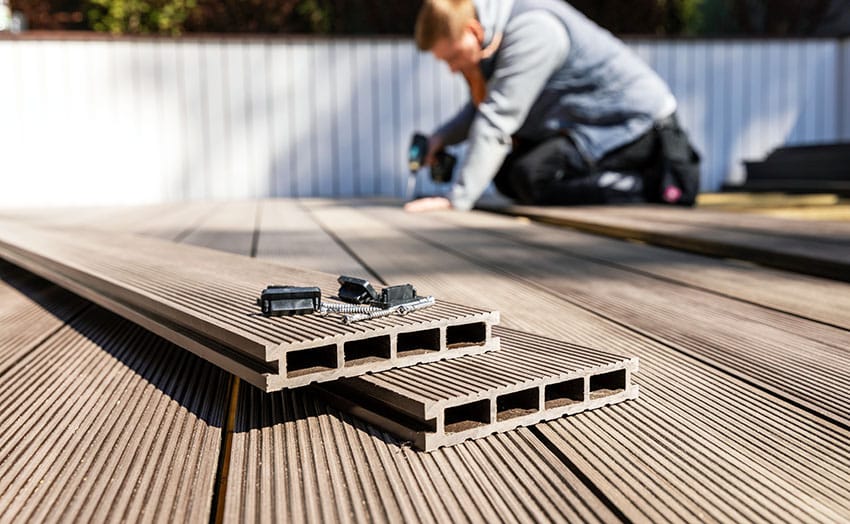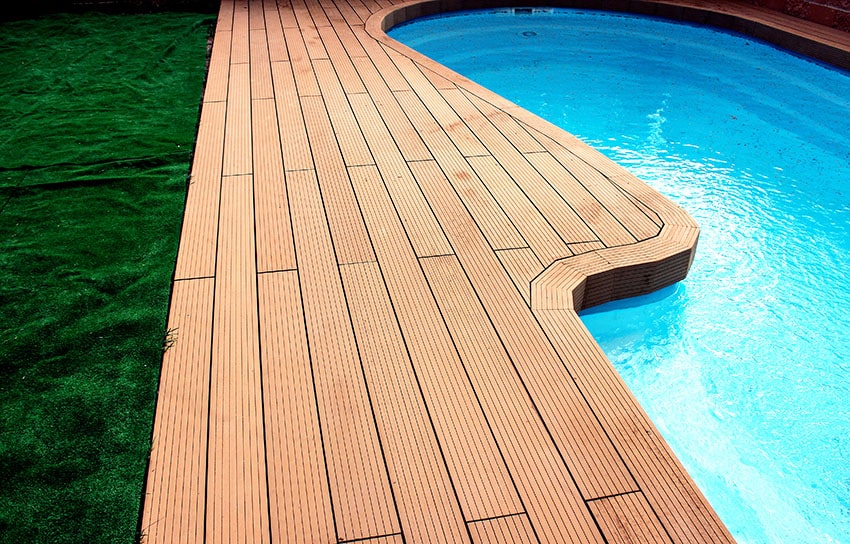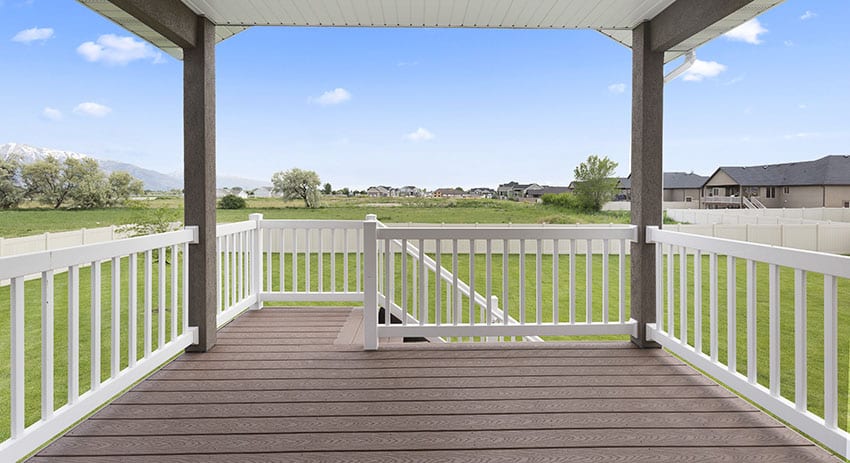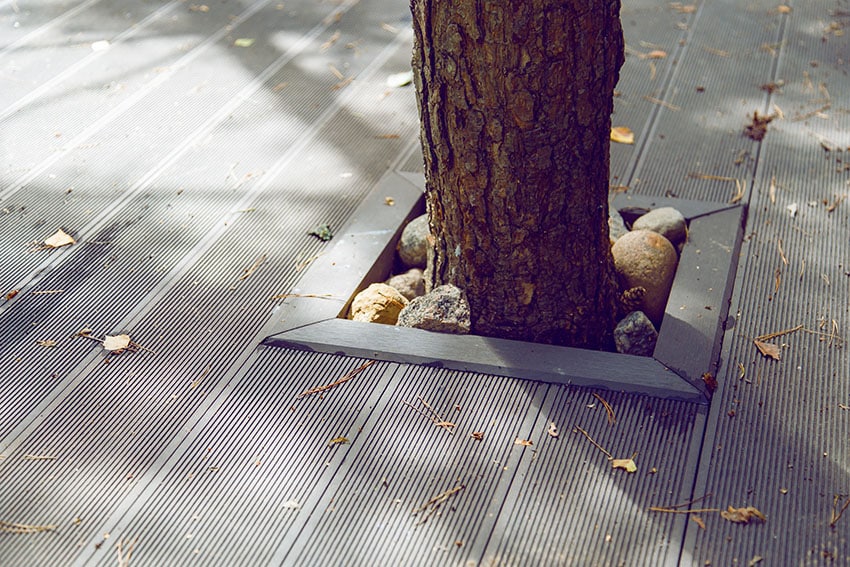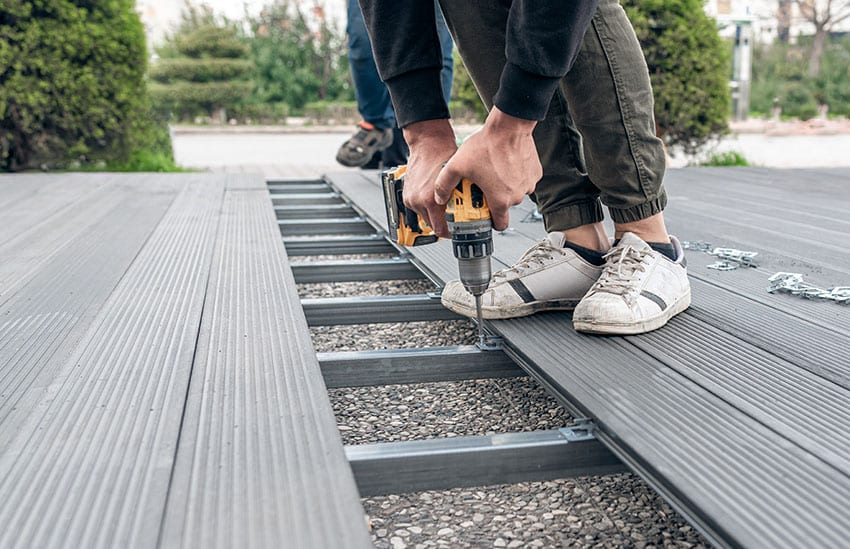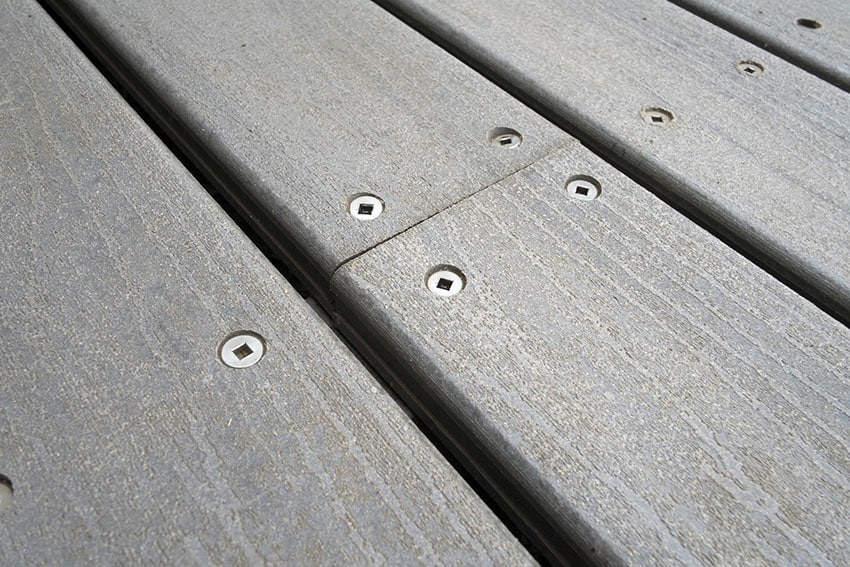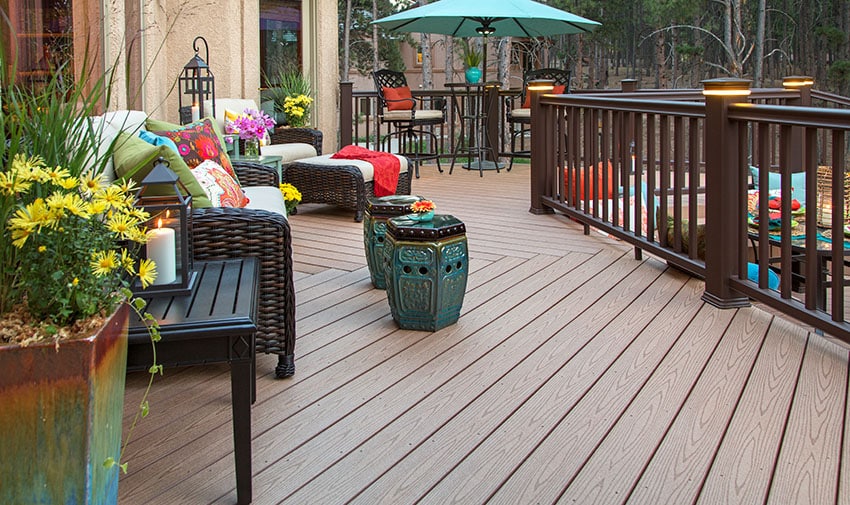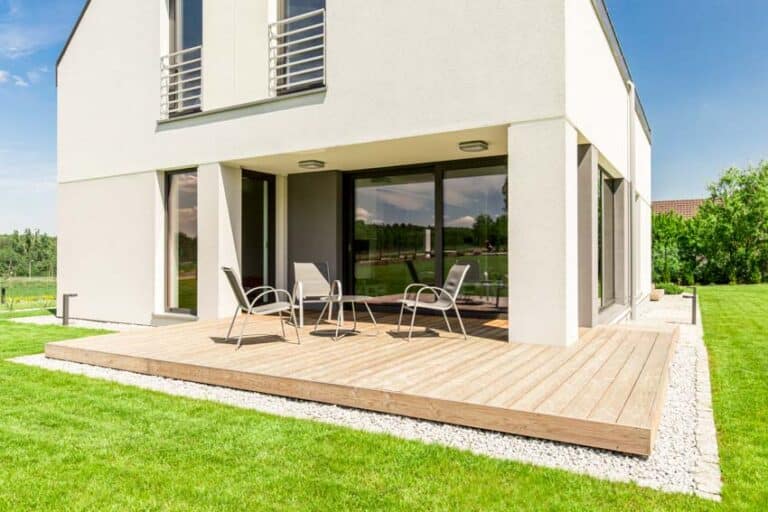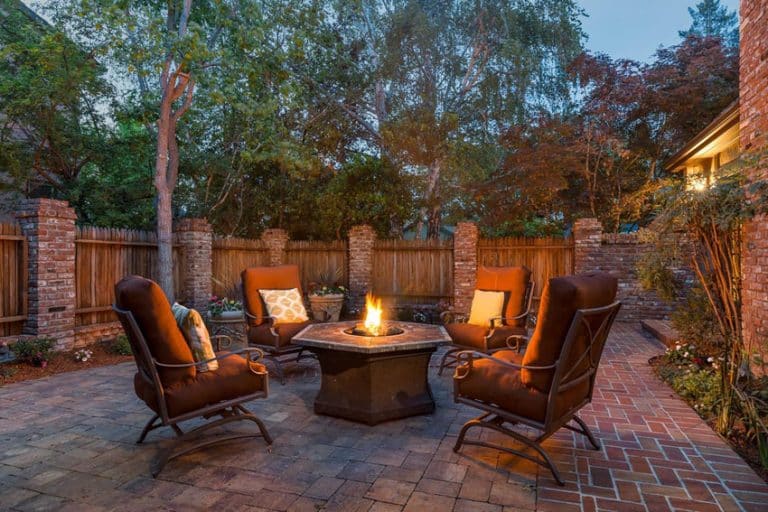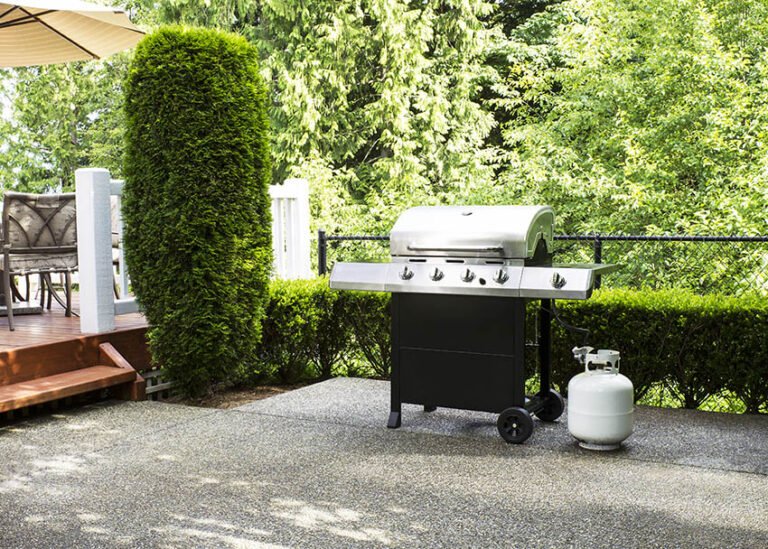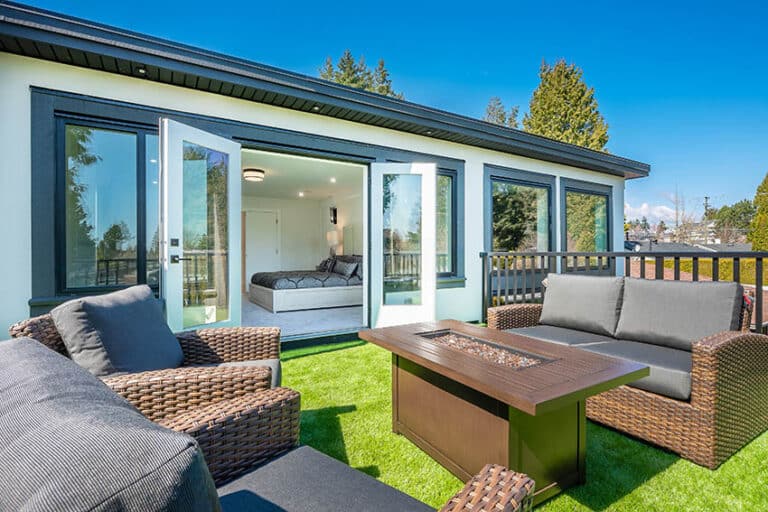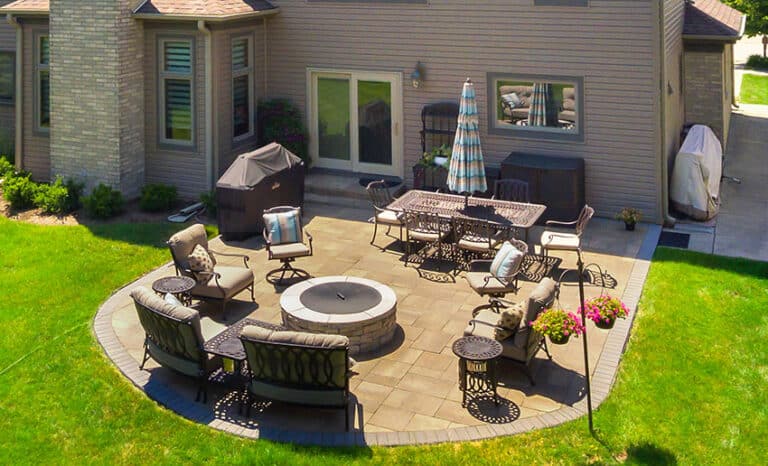Composite Decking Pros and Cons to Enhance Your Backyard
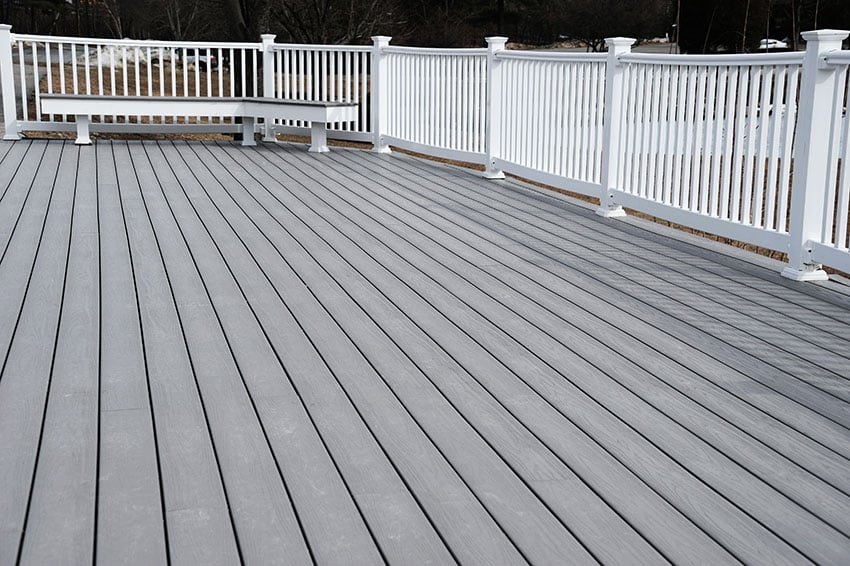
Composite decking has many pros and very few cons. In fact, unless you’re dead set on the look and feel of real wood, there is no reason to choose wooden decking over composite decking.
The pros of composite decking include its eco-friendliness, minimal maintenance requirements, high durability, and extraordinary longevity, especially when compared to wood. One of the only drawbacks is the upfront cost, but the savings in maintenance and repair over the life of the deck make up for this initial investment.
To feel confident in your decision and enjoy your deck for many years to come, composite materials are almost certainly the right choice. Learn more about this style of decking and what you can expect from this durable, attractive material.
Why Use A Composite Deck?
Composite decking is made up of individual planks, usually with interlocking grooves machined into the sides. These grooves help align the one board with the next, ensuring a smooth and stumble-free deck surface. Installation of a composite deck is simple and easy. Some deck materials are manufactured with hidden fasteners, allowing a deck to be assembled without screw holes on the surface.
The planks themselves are highly uniform and come in natural shades such as black, gray, beige, and various browns. Their design can incorporate raised patterns or designs to keep the surface from becoming slippery. Wood grain patterns are popular and remarkably convincing. But there’s no need to hide the fact that your decking is composite. Ridged composite decking is an attractive and slip-free decking material.
Composite planks may have a hollow or solid core. They are manufactured using an extrusion process. Wood fibers, plastics, and bonding agents are melted together and then forced through a machine that shapes them into durable, weather, and insect-resistant timber.
Advantages Of Composite
The advantages of composite decking extend from the materials and process used to construct it, to the ease of installation and maintenance and on to its exceptional durability and longevity.
Eco-friendly – The manufacturing process uses primarily recycled materials. The plastic used is often made of recycled milk bottle chips. Some suppliers even choose to use recycled wood chips, making the lumber both environmentally friendly and sustainable.
Weatherproof – As an exterior structure, your deck experiences the full range of weather conditions in your area. Changes in humidity or temperature can bend or warp wood decking, but composite materials will never warp, swell, or twist.
Precipitation can encourage fungus, mold, and mildew to grow in wood, but this style is impervious to this type of damage.
Pest Proof – Since wood is a food source for many types of insects, wood decks must be carefully watched for signs of infestation. Although it contains wood fiber, it is not appetizing or hospitable to pests, giving you one less thing to worry about.
Durable – The perfectly formed and even surface of each plank is not easily scratched, dented, gouged, or chipped. It doesn’t twist, warp, or rot.
As long as you take appropriate care of your deck surface and clean it every so often, the integrity of the structure can be expected to last a long time.
Virtually Maintenance Free – Wood decks need to be stripped, sanded, and resealed every year. Not only does this cost money and use up valuable free time, you need to wait for the right day to perform maintenance or risk damaging your deck. An improperly cared for wooden deck will quickly fall into disrepair.
Your deck should be an oasis of calm and relaxation, not a time-consuming burden. The material never needs to be stripped, scraped, sanded, or sealed.
The only maintenance required is a wash once or twice a year. A gentle brush and mild detergent should be all you need to scrub the area clean.
Slip Resistant – Composite decking can be a great choice for patios and decks near pools, fountains, or other water features.
When composite decking planks are formed, they include a raised pattern on the top surface. This helps prevent slipping and sliding, even in bare feet, on a wet surface, or when the weather is icy.
Can Be Stain Resistant – Deck planks can be sold with or without a protective plastic coating. When used to refer to boards, ‘capped’ means that the material is protected. Composite material sold with no protection is called ‘uncapped’.
If you choose capped products, the planks will be treated and protected before they arrive and are installed. Capped planks are impervious to all fluid, which makes them impossible to stain. While it’s possible to stain uncapped material, it’s still much harder to discolor than wood.
Can Be Fade Resistant – The harsh, bright, ultraviolet rays of the sun are another potential source of damage to your deck, causing fading over time.
Uncapped products will gradually fade in color, although some formulations contain less lignin than wood and, therefore are not as susceptible to graying.
Capped composite decking, however, will retain close to the same color for it’s entire useful life, thanks to UV blocking and absorbing technology used in the construction of the protective coating.
Comes With a Guarantee – Most brands guarantee uncapped decking for at least 15 years and offer guarantees on capped materials that are at least 25 years.
Disadvantages of Composite
Although composite decking has incredible properties that make it an obvious choice for most decks, there are some drawbacks to using this material.
Expensive – If you choose composite, your upfront costs will be slightly higher than wood. However, the price difference is erased when you consider the time and effort wood decks require for maintenance, as well as their tendency to need repair.
Not Real Wood – Another potential drawback is that it’s not real wood. However, most people can’t tell the difference between a composite deck and a new wood deck unless they are standing on it. With realistic wood grain patterns adding verisimilitude and no chance of splinters, you could even call composite an improvement over real wood!
May Emit Harmful Fumes – Because this material is made from petroleum products, there may be a concern about off-gassing volatile organic compounds, so decking products should not be stored in the interior of your home before installation.
Composite Durability
Composite decking is highly durable, especially when capped. The protective plastic coating prevents fading and staining. Both capped and uncapped planks can resist all kinds of damage, from impact to moisture or fungus and mildew.
Some products are able to ‘heal’ small scratches, which should fade in just a few weeks. Individual boards can be replaced in the event of major damage.
Depending on the manufacturer, location, and care taken, it’s possible for a deck made of composite material to last for 50 years before it stops functioning.
How Long Will Composite Material Decking Last?
Composite decking can be expected to last a minimum of 25-30 years, depending on quality, maintenance habits, and environmental conditions, with some products boasting a 50-year lifetime guarantee.
Most manufacturers guarantee their product for a given number of years. With uncapped products, that number is usually 15 years, although uncapped material can easily last another five years past the guarantee before needing replacement or repair.
Capped composite decking is guaranteed for longer, usually around 20 or 25 years, and you can generally expect it to make it to at least 30 years.
Composite Cost
Composite decking costs between $10 and $30 per square foot and can be purchased directly from big box stores. On the low end, an 8 x 8 deck made with composite might cost $1,728 ($768 for the amount of materials and $960 for labor.
The same project with more expensive composite decking in a higher cost of labor area could cost $3,648 ($1,408 for materials and $2,240 for labor). Costs rise for decks that are larger in size or irregular in shape. Read more about deck sizes here.
With pressure-treated wood dropping as low as $3 per square foot in some locations, it is no wonder some people are under the impression that all-wood decks are cheaper than composite decks. However, this just isn’t true.
The labor to install decking will cost the same whether the decking is wood or composite (although labor costs do vary by location). Expect to pay between $15 and $35 per square foot for labor. You may find you save on labor costs because these projects are easier and quicker to install.
Two of the biggest companies that provide this decking are Trex and Timbertech. Trex decking is generally a little less expensive to buy. See the differences between Trex vs. Timbertch decking here.
While planning the creation of your deck you can use one of the deck design software programs that help you calculate the cost of materials. This may also help you get a better idea as to the amount materials you’ll need for the project.
Composite is also less expensive to maintain than all-wood decking. Maintenance costs are very limited, as only household products are required. Maintaining an all-wood deck requires a pressure or power washer, special cleanser, and regular reapplication of sealant.
Even when you complete all this maintenance, water or insect damage could make your deck unsafe, necessitating costly repairs. Composite is impervious to water and insect damage, and should not ever need to be repaired.
As an alternative to composite decks you may want to consider PVC. This material is similar in composition but costs less overall to purchase. Read more about the differences between composite vs. PVC decking here.
Composite Maintenance
The only maintenance required for composite boards is regular gentle cleaning.
Composite decking should ideally be cleaned every six months, but luckily this is not a labor-intensive task. A regular garden hose will wet the surface of the decking. Baking soda and vinegar can be used as a cleaning solution and will loosen the grit and grime.
A soft-bristled brush is used to work the cleaning solution into more stubborn areas. Once the deck is clean, simply rinse with the hose and enjoy a sparkling deck with no need to scrape, stain, or seal.
You can also choose to use a commercial cleaning product, but there are restrictions you must observe. Avoid formulations that include chlorine bleach or sodium hypochlorite as they can damage the structure of the boards and cause unwanted side effects such as discoloration.
Do You Need to Seal Composite for Decks?
You do not need to seal composite decking. At the time of purchase and installation, you have the choice between capped and uncapped composite decking.
All composite products, including uncapped composite decking, are resistant to moisture, rot, and pests. If the decking you choose is capped, a plastic coating is applied to the exterior of the board during the manufacturing process, enabling it to also resist fading and staining.
Either way, once the deck has been installed, it does not need to be sealed or resealed and retains a like-new appearance for 15-25 years.
Are Decks Made of Composite Worth It?
The initial expense of installing composite decking is higher than that of wood, but it’s absolutely worth it in the long run.
A wood deck may be cheaper to install, but it requires a lot more time and effort to maintain. Even if you’re happy to do the labor yourself you still have to purchase supplies and materials to clean, strip, and reseal the wood, which must be repeated annually. If you don’t already own a pressure washer, you must also rent and transport one for semi-annual cleaning.
Even with all this extra effort and expense, the cheapest wood deck options won’t last more than ten years. Hardwood decking could last a little longer, but the maximum lifespan is around 15 years.
During that time, you’ll need to watch for signs of pest infestation or moisture damage and may need to repair or replace affected boards. Splinters are also an issue with wood decks and can take all the fun out of stepping onto your deck barefoot. Composite projects have none of these issues.
Capped composite is guaranteed for 25 years, and can be expected to last even longer than that. While the guarantee on uncapped composite expires after 15 years, it has a good chance of standing up much longer than that.
Composite materials will not warp, rot, or become infested with pests. It cannot give you a splinter. If you spring for the capped version, it won’t even fade.
When you review the pros and cons of composite decking, it’s clearly one of those products that’s worth the investment. You can count on enjoying the payoff for a long time, with minimal extra effort after installation.
Visit our cedar decks pros and cons for more related content.

